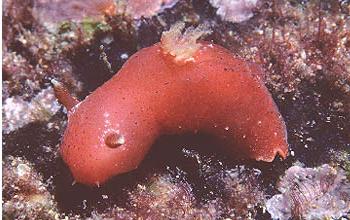
Nembrotha arnoldi
Burn, 1957
Order: NUDIBRANCHIA
Suborder: DORIDINA
Superfamily: ANADORIDOIDEA
DISTRIBUTION
Known from southeastern Australia (Victoria, South Australia).
PHOTO
Portsea Pier, Victoria, Australia on 19 December 2000. The specimen was one of two found in close proximity on the bottom at a depth of 4.5m. It is 13mm in length. Photo: John Chuk.
First described from Victoria by Burn (1957), it was placed by him in the genus Nembrotha because of its general external appearance. It was later (Burn, 1973) removed to the genus Gymnodoris, but I know of no published anatomical information on this species. Burn mentions a spiculate skin. I doubt whether it is a species of either Nembrotha or Gymnodoris.
References:
• Burn, R.F. (1957) On some Opisthobranchia from Victoria. Journal of the Malacological Society of Australia, 1: 1-20
• Burn, R.F. (1975) A list of the dorid nudibranchs of Australia (Gastropoda, Opisthobranchia). Journal of Zoology, London, 176: 477-517.
Rudman, W.B., 2001 (March 18) Nembrotha arnoldi Burn, 1957. [In] Sea Slug Forum. Australian Museum, Sydney. Available from http://www.seaslugforum.net/find/nembarno
Related messages
Gymnodoris arnoldi from Victoria, Australia
March 21, 2001
From: John Chuk

Dear Bill,
Here is a picture of a nudibranch that I took on a night dive at Portsea Pier, Victoria, Australia on 19/12/2000. The specimen was one of two found in close proximity on the bottom at a depth of 4.5m. It is 13mm in length. I suspect that it is Gymnodoris arnoldi.
The reason for sending this picture is that this animal looks very similar to the specimen found at the same site and listed in the Forum as Polycera? sp.5. What do you think?
Best Wishes.
John
jchuk@giant.net.au
Chuk, J., 2001 (Mar 21) Gymnodoris arnoldi from Victoria, Australia. [Message in] Sea Slug Forum. Australian Museum, Sydney. Available from http://www.seaslugforum.net/find/3983Dear John,
I think you are right on both counts. However, what we should call this animal is not so clear. Bob Burn described it as Nembrotha arnoldi and later placed it in the genus Gymnodoris [see top of page for references]. However I know of no anatomical information on this species. Burn's mention of a spiculate skin make it unlikely that this species belongs in either of these genera. I wouldn't mind some specimens if you find it again.
Best wishes,
Bill Rudman
